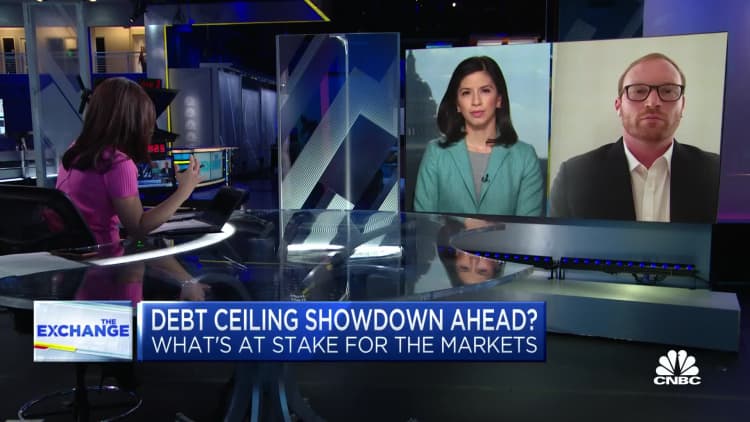U.S. Treasury Secretary Janet Yellen on Jan. 10, 2023 in Washington.
Kevin Dietsch | Getty Images News | Getty Images
The U.S. may be about to hit its debt ceiling.
Treasury Secretary Janet Yellen said last week that the U.S. would likely hit the ceiling Thursday. Absent steps taken by Congress, the event may “cause irreparable harm to the U.S. economy, the livelihoods of all Americans, and global financial stability,” she wrote in a letter to new House Speaker Kevin McCarthy, R-Calif.
Here’s what the debt ceiling is, and what makes it so important for consumers.
What is the debt ceiling?
The debt ceiling is the amount of money the U.S. Treasury is authorized to borrow to pay its bills.
Those obligations include Social Security and Medicare benefits, tax refunds, military salaries and interest payments on outstanding national debt.
The current ceiling is about $31.4 trillion. Once it’s hit, the U.S. is unable to increase the amount of its outstanding debt — and paying its bills becomes trickier.
More from Personal Finance:
4 key money moves in an uncertain economy
Why the price of smartphones, used cars and bacon deflated in 2022
Evictions are picking up across the U.S.
“Not unlike many households, the government is reliant on debt to fund its obligations,” said Mark Hamrick, a senior economic analyst at Bankrate. “And like many households, it doesn’t have sufficient income to fund its expenses.”
The debt ceiling wouldn’t be an issue if U.S. revenues — i.e., tax proceeds — exceeded its costs. But the U.S. hasn’t run an annual surplus since 2001 — and has borrowed to fund government operations each year since then, according to the White House Council of Economic Advisers.
Why is the debt ceiling an issue right now?
While the U.S. is expected to reach its $31.4 trillion borrowing cap on Thursday, this in and of itself isn’t the major issue.
The Treasury has temporary options to pay bills: It can use cash on hand or spend any incoming revenues, such as those during tax season, which starts Jan. 23.
It can also use so-called “extraordinary measures,” which free up money in the short term. The Treasury will start using such measures this month, Yellen said. They include a redemption or suspension of investments in certain federal retirement and disability funds. The funds would be made whole later.
These maneuvers are meant to prevent a potential calamity: a default.

A default would occur if the U.S. runs out of money to meet all its financial obligations on time — for instance, missing a payment to investors who hold U.S. Treasury bonds. The U.S. issues bonds to raise money to finance its operations.
The U.S. has defaulted on its debt just once before, in 1979. A technical bookkeeping glitch resulted in delayed bond payments, an error that was quickly rectified and only affected a small share of investors, the Treasury said.
However, the U.S. has never “intentionally” defaulted on its debt, CEA economists said. This outcome is the one Yellen warned would cause “irreparable harm.” The scope of negative shockwaves is unknown since it hasn’t happened before, economists said.
“The fallout is serious,” said Mark Zandi, chief economist at Moody’s Analytics.
“It would create chaos in financial markets and completely undermine the economy,” he added. “The economy would go into a severe recession.”
Fallout: Frozen benefits, a recession, pricier borrowing
An exact default date is difficult to pinpoint, due to the volatility of government payments and revenues. But it’s unlikely to happen before early June, Yellen said.
Congress can raise or temporarily suspend the debt ceiling in the interim to avert a debt-ceiling crisis — something lawmakers have done many times in the past. But political impasse calls their ability or willingness to do so into question this time around.
[A default] would create chaos in financial markets and completely undermine the economy.Mark Zandi
chief economist at Moody’s Analytics
If the U.S. were to default, it would send several negative shock waves through the U.S. and global economies.
Here are some of the ways it could affect consumers and investors:
1. Frozen federal benefits
Tens of millions of American households might not get certain federal benefits — such as Social Security, Medicare and Medicaid, and federal aid related to nutrition, veterans and housing — on time or at all, the CEA said. Government functions such as national defense may be affected, if the salaries of active-duty military personnel are frozen, for example.
2. A recession, with job cuts
Affected households would have less cash on hand to pump into the U.S. economy — and a recession “would seem to be inevitable” under these circumstances, Hamrick said. Recession would be accompanied by thousands of lost jobs and higher unemployment.
3. Higher borrowing costs
Investors generally view U.S. Treasury bonds and the U.S. dollar as safe havens. Bondholders are confident the U.S. will give their money back with interest on time.
“It’s sacrosanct in the U.S. financial system that U.S. Treasury debt is risk-free,” Zandi said.
If that’s no longer the case, ratings agencies would likely downgrade the U.S.’ sterling credit rating, and people will demand much higher interest rates on Treasury bonds to compensate for the additional risk, Zandi said.
Borrowing costs would rise for American consumers, since rates on mortgages, credit cards, auto loans and other types of consumer debt are linked to movements in the U.S. Treasury market. Businesses would also pay higher interest rates on their loans.
4. Extreme stock market volatility
Of course, that’s assuming businesses and consumers could get credit. There might also be a “severe” financial crisis if the U.S. government is unable to issue additional Treasury bonds, which are an essential component of the financial system, Hamrick said.
“A default would send shock waves through global financial markets and would likely cause credit markets worldwide to freeze up and stock markets to plunge,” the CEA said.
Even the threat of a default during the 2011 debt ceiling “crisis” caused Standard & Poor’s (now known as S&P Global Ratings) to downgrade the credit rating of U.S. and generated considerable market gyrations. Mortgage rates rose by 0.7 to 0.8 percentage points for two months, and fell slowly thereafter, the CEA said.
 EU News Digest Latest News & Updates
EU News Digest Latest News & Updates


